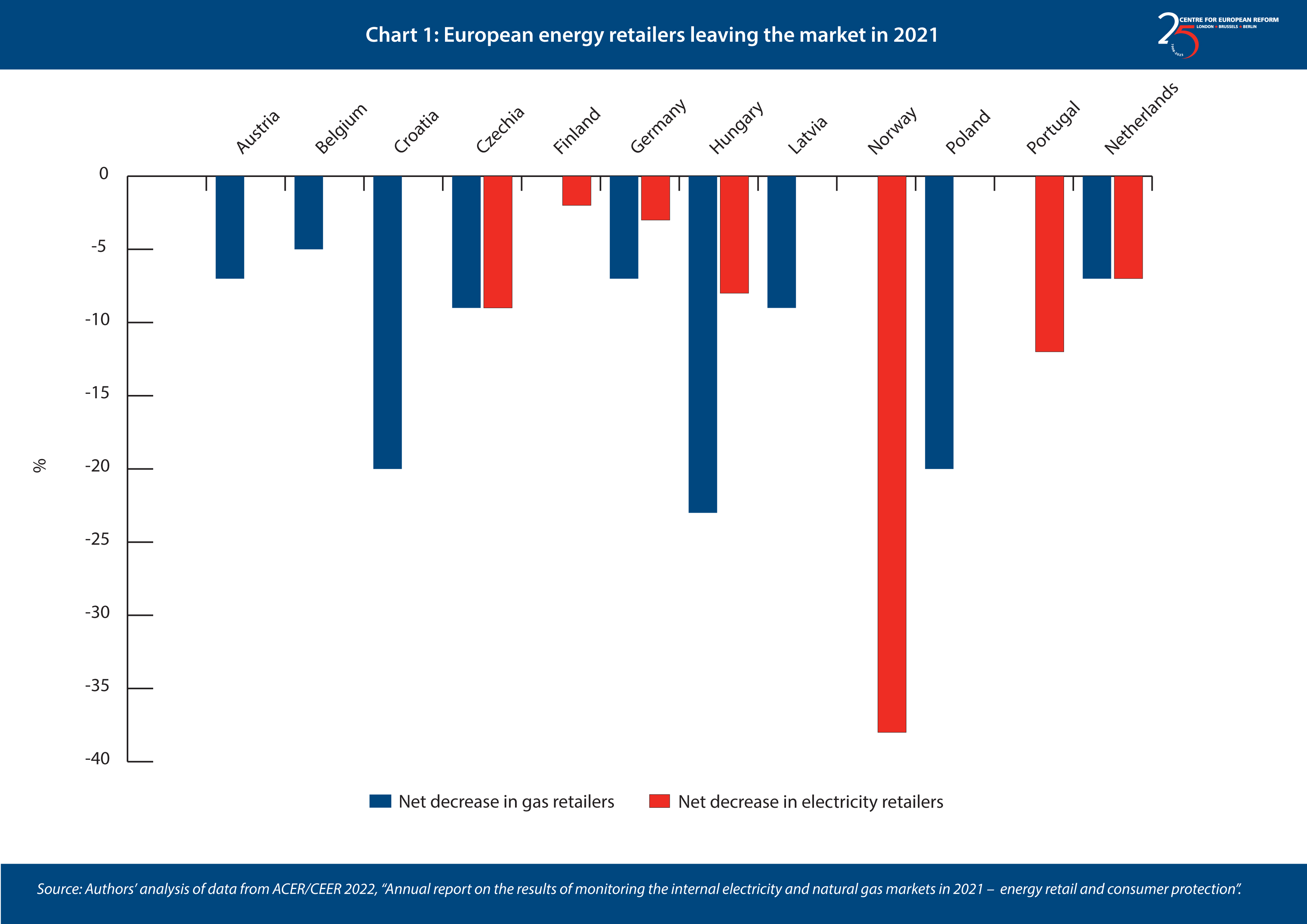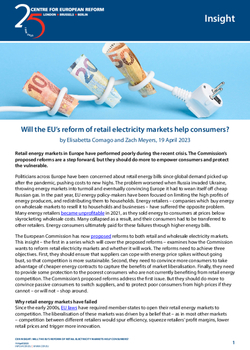
Will the EU's reform of retail electricity markets help consumers?
Retail energy markets in Europe have performed poorly during the recent crisis. The Commission’s proposed reforms are a step forward, but they should do more to empower consumers and protect the vulnerable.
Politicians across Europe have been concerned about retail energy bills since global demand picked up after the pandemic, pushing costs to new highs. The problem worsened when Russia invaded Ukraine, throwing energy markets into turmoil and eventually convincing Europe it had to wean itself off cheap Russian gas. In the past year, EU energy policy-makers have been focused on limiting the high profits of energy producers, and redistributing them to households. Energy retailers – companies which buy energy on wholesale markets to resell it to households and businesses – have suffered the opposite problem. Many energy retailers became unprofitable in 2021, as they sold energy to consumers at prices below skyrocketing wholesale costs. Many collapsed as a result, and their consumers had to be transferred to other retailers. Energy consumers ultimately paid for these failures through higher energy bills.
The European Commission has now proposed reforms to both retail and wholesale electricity markets. This insight – the first in a series which will cover the proposed reforms – examines how the Commission wants to reform retail electricity markets and whether it will work. The reforms need to achieve three objectives. First, they should ensure that suppliers can cope with energy price spikes without going bust, so that competition is more sustainable. Second, they need to convince more consumers to take advantage of cheaper energy contracts to capture the benefits of market liberalisation. Finally, they need to provide some protection to the poorest consumers who are not currently benefiting from retail energy competition. The Commission’s proposed reforms address the first issue. But they should do more to convince passive consumers to switch suppliers, and to protect poor consumers from high prices if they cannot – or will not – shop around.
Why retail energy markets have failed
Since the early 2000s, EU laws have required member-states to open their retail energy markets to competition. The liberalisation of these markets was driven by a belief that – as in most other markets – competition between different retailers would spur efficiency, squeeze retailers’ profit margins, lower retail prices and trigger more innovation.
EU member-states embraced this philosophy to different degrees in the past. The UK was the exemplar: it exuberantly welcomed new entrants and, by 2018, had over 70 energy retailers. Competition across Europe has given consumers a greater variety of tariffs – traditionally based on either a fixed price per unit of energy or a variable price reflecting changes to energy supply and demand – and overall lower energy bills. Yet this seemingly thriving competition hid two weaknesses.
First, there was plenty of evidence that not all consumers were benefiting from competition. Some incumbent retailers maintained high operating costs – for example, by paying their staff above-market rates – or kept excessive margins without losing many customers. Between 2014 and 2019, Britain’s energy retailers imposed the highest mark-ups in the EU, despite the large number of new market entrants and the deregulation of retail prices, followed by Belgium, Ireland and Germany. Large retailers could do this because only a minority of households would regularly switch to another supplier – even if it was much cheaper. Countries with the highest switching rates among household consumers were the Netherlands, Belgium and Britain, but even in these countries the annual rates of consumer switching in 2020 were only around 20 per cent.
Retail energy markets became bifurcated between ‘active’ customers who would shop around, and ‘inactive’ customers who did not. Active customers typically chose cheaper deals that fixed the price over a set period. Inactive customers were usually put on ‘default’ variable tariffs, with higher and more volatile prices. Retailers therefore typically offered cheap deals to new customers, sometimes at a loss-making margin, in the hope those customers would then become inactive and fall onto a more expensive default tariff once their deal expired.
Competition probably benefited all customers: retailers cannot be sure which customers might leave, so they have incentives to keep all their customers satisfied. However, richer and older customers tended to gain more financial benefits from competition: evidence from eight EU countries indicates that older and richer people are more likely to switch to a different energy retailer. In many cases, this is because poorer or less educated consumers have less understanding of their choices, have less trust in the market or perceive the switching process to be too complex. In other cases, they may be unable to switch, for example if they rent without having an energy account in their own name. Regulators have been reluctant to protect inactive customers, because it might dampen incentives to switch. However, even before the energy crisis, many countries had price caps to provide a degree of protection for consumers who could not or would not shop around. In the recent crisis, more governments have reintroduced or extended these price caps, albeit temporarily.
A second weakness of thriving competition was that, as Chart 1 shows, many new retailers across Europe were operating unsustainable business models and exited the market (usually because they went bankrupt) once wholesale energy prices increased in 2021. To responsibly offer cheap deals to attract new customers, the retailers should have addressed the risk that wholesale prices would rise over the course of the consumer’s contract. For example, retailers could have signed long-term fixed-price wholesale contracts, as opposed to buying electricity on the spot market, closer to the time of delivery. Many did not, because hedging against the risk of higher prices is expensive and ties up retailers’ cash. But when wholesale prices increased, they were forced to supply energy at a loss.

Many were then forced into bankruptcy and their customers transferred to other retailers. In some countries, retailers recouped the cost of taking on loss-making contracts through higher energy bills on all consumers. The use of ‘loss leading’ tariffs to entice new customers, and the socialisation of subsequent retailer failures, meant that consumers who actively switch between retailers were subsidised by inactive consumers, who had benefited less from competition in the first place.
These problems illustrate the dilemmas at the heart of EU retail energy policy. Competition has increased consumers’ choices, but these offers have not always been sustainable. And there is a tension between promoting switching and avoiding unequal outcomes between different groups of consumers. EU-level reforms therefore need to tackle these problems, to ensure retail energy markets perform better once the war-induced temporary price caps end.
The EU proposals
On March 14th, 2023, the Commission published a proposal to reform the EU’s electricity market. The proposals do a good job at making competition more sustainable. For example, the Commission would require retailers to hedge against rises in wholesale prices to cover their fixed-term contracts. Adequate hedging is costly, so these reforms would benefit larger retailers and would probably increase prices for the cheapest tariffs. But these rules aim to ensure fixed-term deals are sustainable, reducing the risk of retailers taking irresponsible bets and going bust, and giving consumers more confidence in the market. The challenge for regulators will be to encourage big retailers to expand across member-states rather than solely relying on market entry by small firms. It will create more robust competition if retailers with deep pockets, who can comply with hedging requirements, operate in different countries. Regulators will also have the challenge of enforcing the rules when wholesale short-term prices fall, because retailers will then be tempted to buy more energy on the cheaper spot market and reduce their hedging efforts.
For more robust competition, the EU’s energy regulators should encourage big retailers to expand across member-states rather than solely relying on market entry by small firms.
The Commission will also require member-states to implement a ‘supplier of last resort’ regime. These regimes already exist in many member-states. They provide an orderly process to move customers of failed retailers to another one, preventing situations in which suppliers refuse to take on new consumers during a crisis. If well designed, these regimes can help reduce and distribute the costs of a retailer failing, and help mitigate the impact on stranded consumers. The Commission is right to ensure national regulators’ have this tool.
The proposals do less well in encouraging inactive consumers to switch retailers. For example, the Commission wants to give consumers a wider variety of contracts. Consumers would always be entitled to at least one fixed-term contract, with a fixed price, and at least one variable-price contract, with a price which varies based on changes in wholesale prices. They would also have the right to have more than one retailer supply their home.
More choice is generally a good thing, but in practice these choices could disproportionately benefit already engaged consumers, rather than persuading previously inactive consumers to start shopping around. For example, the consumers who will most benefit from having multiple retailers will be sophisticated, and may have special energy needs – like an electric vehicle they wish to charge overnight at a lower price. National regulators have been concerned that excessive and complex choices are part of the reason why many consumers do not switch suppliers. The Commission proposal does emphasise the need for retailers to use “simple and concise language”. Consumers can compare energy tariffs across retailers in a simple format on independent comparison websites in most EU countries, but inert consumers may not consult them in the first place. Energy regulators should consider playing a larger role in filling the information gap for consumers, for example, by directly contacting them with suggestions of alternative tariffs. This should become easier as smart meters become more pervasive and offer more detailed portraits of consumers’ energy needs.
Energy regulators should consider playing a larger role in filling the information gap for consumers, for example, by directly contacting them with suggestions of alternative tariffs.
The reforms should also have built on the successes of some European energy regulators in increasing switching. For example, in Italy, the regulator moved groups of inactive customers to new retailers via an auction process, in which retailers bid to supply the customers at the lowest possible price. This allowed customers who could not, or would not, choose another retailer to enjoy some of the benefits of competition once they eventually shifted away from the incumbent retailer. EU energy laws already provide for such ‘collective switching’, but they could make it easier – for example, by explicitly allowing inactive consumers to enjoy collective switching unless they opt out. Similarly, the Commission could help consumers use innovative new services, like automatic switching. For example, more ambitious reforms could have made it easier for consumers to share their energy data with third parties, like price comparison websites, to help them seek out good value offers. Similar reforms have already shown promise in the banking sector.
Finally, the Commission addresses the trade-offs involved with protecting consumers during energy price surges. It wants member-states to stop vulnerable customers from having their energy supplies disconnected. It will also allow member-states to impose price caps below retailers’ costs during a regional or EU-wide electricity price crisis, in order to protect households and small to medium-sized businesses. Although existing EU energy laws do not prohibit retail price caps, the Commission rightly frets that they distort markets. At the same time, there is a risk that gas prices spike again, and with them electricity prices: as Europe shifts away from pipeline gas imports and towards higher imports of liquefied natural gas (LNG), its power market will be more exposed to volatility in global gas prices.
The proposal constrains how below-cost price caps can be implemented during a price spike, which will limit governments’ ability to overuse them. First, it would be up to the Commission to declare a regional or EU-wide electricity price crisis if certain conditions are met. Second, national governments would need to chip in to ensure retailers’ costs were covered. Price caps would also not apply to energy consumption in general, but only to a certain share of it – 80 per cent of a median household’s consumption and 70 per cent of a small or medium-sized enterprise’s consumption in the previous year. This is so that consumers are not entirely insulated from wholesale price levels, and are still incentivised to save energy – which they may not do if their full energy consumption is subsidised. These conditions limit governments’ room for manoeuvre in intervening in power markets, and try to mainstream design practices that would preserve price signals on a portion of consumption even during a crisis. Regulators are right not to be too worried about switching incentives in such a crisis, when there are probably no cheap deals for consumers to benefit from, and for now, there is little evidence that temporary price caps depress switching rates permanently.
Nevertheless, by focusing on emergency price caps, the Commission pays insufficient attention to alternative ways to help inactive consumers once currently high prices fall. The Commission should encourage governments to help consumers pay their energy bills through cash transfers instead of price caps in the event of another price spike. Transfers allow government hand-outs to be targeted at those in need and they do not interfere with consumers’ incentives to shop around and to save energy.
Conclusion
EU retail energy markets have failed to deliver for all consumers. The Commission’s proposed reform will make the market more resilient. But it could do more to encourage consumers to switch, rather than providing more benefits to consumers who are already energy-savvy. Well-intended provisions for emergency price caps are also not the best option: governments would better protect vulnerable consumers by giving them cash transfers instead.
Besides the weaknesses undermining retail markets, it is high prices that remain the biggest problem in energy markets today. Given the large role that wholesale energy prices have played in the current crisis, most attention will be focused on the Commission’s proposals to reform the design of wholesale markets – including its efforts to incentivise more cheap renewable energy generation and stop high gas prices driving up the cost of electricity. We will turn to this issue in the next insight in this series.
Elisabetta Cornago and Zach Meyers are senior research fellows at the Centre for European Reform.



Add new comment